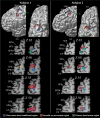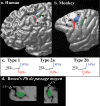Local morphology predicts functional organization of the dorsal premotor region in the human brain
- PMID: 16525051
- PMCID: PMC6675158
- DOI: 10.1523/JNEUROSCI.4739-05.2006
Local morphology predicts functional organization of the dorsal premotor region in the human brain
Abstract
A confusing picture of the functional organization of the dorsal premotor region of the human brain emerged when functional neuroimaging studies that either examined visuomotor hand conditional activity or attempted to localize the human frontal eye field reported activity increases at the same general location, namely the junction of the superior precentral sulcus with the superior frontal sulcus. The present functional magnetic resonance imaging study examined visuomotor hand conditional activity and the locus of the frontal eye field as defined by a standard task, on a subject-by-subject basis, to clarify their location and reveal relationships between the pattern of local morphology and functional activity. The results demonstrate that visuomotor hand conditional activity and the frontal eye field lie within distinct parts of the superior precentral sulcus, revealing an organization of the human premotor cortex consistent with that observed in experimental studies in the monkey.
Figures





References
-
- Blanke O, Spinelli L, Thut G, Michel CM, Perrig S, Landis T, Seeck M (2000). Location of the human frontal eye field as defined by electrical cortical stimulation: anatomical, functional and electrophysiological characteristics. NeuroReport 11:1907–1913. - PubMed
-
- Boling W, Olivier A, Bittar RG, Reutens D (1999). Localization of hand motor activation in Broca’s pli de passage moyen. J Neurosurg 91:903–910. - PubMed
-
- Boussaoud D, Wise SP (1993a). Primate frontal cortex: neuronal activity following attentional versus intentional cues. Exp Brain Res 95:15–27. - PubMed
Publication types
MeSH terms
Substances
LinkOut - more resources
Full Text Sources
